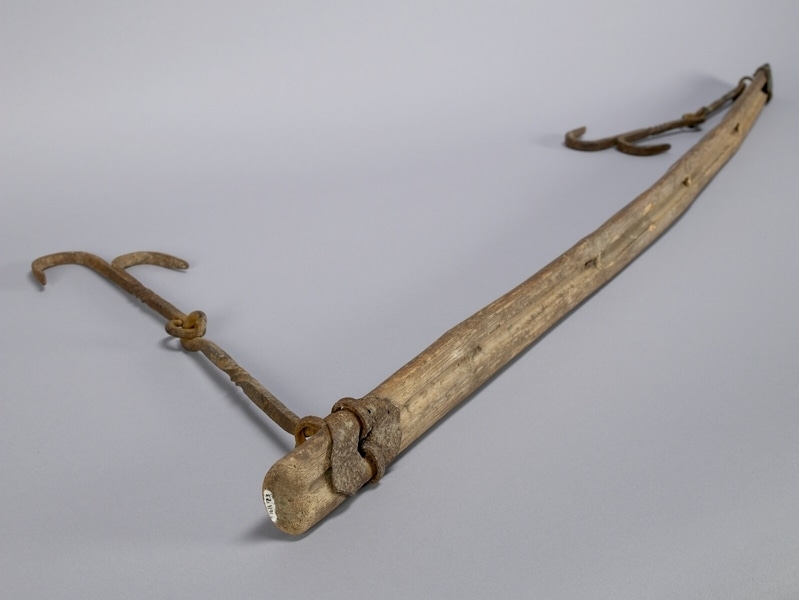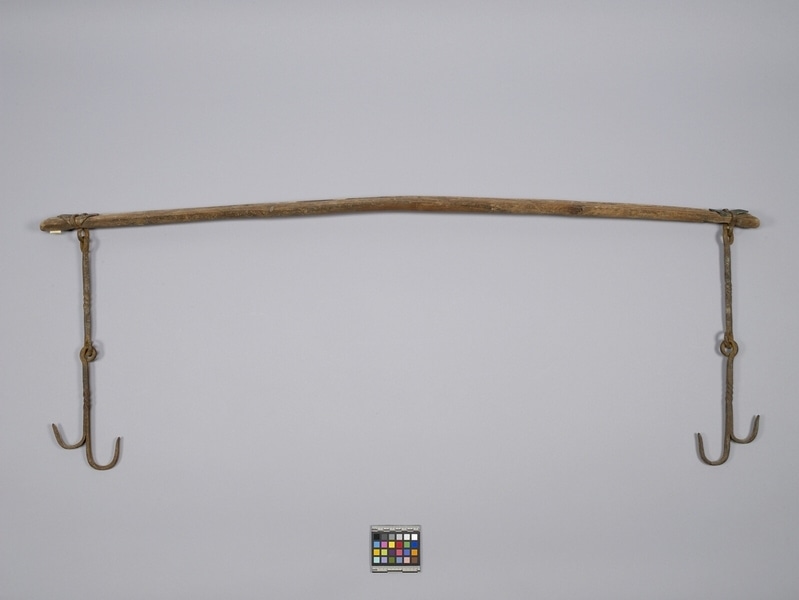Carrying Pole Item Number: Edz1191 from the MOA: University of British Columbia


Description
Length of halved bamboo with jointed double hooks made of iron suspended from either end.
History Of Use
Carrying poles of this type were used by women to carry water from wells. In Tsuen Wan, this was necessary until the early 1960s, when water lines were installed. Carrying two wooden buckets on hooks on the pole, women went to the well that their village or lineage had the right to use. Using the hook, they lowered the bucket into the well, filled it, and raised it. After repeating this with the second bucket, they then carried the water back home. This work was the task of relatively young women who had the strength and stamina to do it. Every evening they had to make many trips to the well so the family would have water for baths as well as for cooking and drinking. In the morning they fetched more. They did this work even throughout pregnancy, and some had to resume it within a few days after giving birth if there was no one else in the household or a close relative to assist them. They began to develop the skill and strength to do this in childhood. All tools, small and large, belonged to the household and were managed by the mother in law, with the exception of the carrying poles used by individual women to carry grass and bracken for fuel. After the mid-twentieth century the New Territories of Hong Kong began to undergo fundamental changes. The people who had been settled there before 1898, when the British colonizers claimed the area, began to give up rice agriculture and coastal fishing, turning instead to wage labour and increased employment overseas. By the end of the century, educational opportunities leading to the possibility of white-collar work also increased, together with western influences. Twentieth-century changes meant that objects and clothing once useful and appropriate were no longer needed and generally were discarded. Some were saved by their owners, who sometimes were willing to donate them to museums, sharing, also, their knowledge of how they were made and used.
Narrative
Yau Chan, Shek-ying recalled going to fetch water for the family one evening and giving birth to their oldest son within a short time afterwards. Hakka people are one of the two original land-dwelling groups that settled the area that became the New Territories of Hong Kong. Their spoken language, and some customs, differed from those of the other original group, the Cantonese or Punti. The Cantonese arrived first and settled on the best rice-growing lands, while the Hakka began to arrive after the late 17th century and settled the more hilly lands.
Item History
- Made in Tsuen Wan, Hong Kong, China during 1960
- Collected by Elizabeth L. Johnson during 1979
- Owned by Shui-cheung Yau and Chan Shek-Ying Yau
- Owned by Elizabeth L. Johnson before March 17, 1980
- Received from Elizabeth L. Johnson (Seller) and Museum of Anthropology Shop Volunteers (Funding source) on March 17, 1980
What
- Name
- Carrying Pole
- Identification Number
- Edz1191
- Type of Item
- pole
- Material
- bamboo grass and iron metal
- Manufacturing Technique
- cut, smoothed and forged
- Overall
- height 45.0 cm, width 127.0 cm, depth 5.0 cm
Who
- Culture
- Chinese: Hakka
- Field Collector
- Elizabeth L. Johnson
- Previous Owner
- Shui-cheung Yau, Chan Shek-Ying Yau and Elizabeth L. Johnson
- Received from
- Elizabeth L. Johnson (Seller) and Museum of Anthropology Shop Volunteers (Funding source)
Where
- Holding Institution
- MOA: University of British Columbia
- Made in
- Tsuen Wan, Hong Kong, China
When
- Creation Date
- during 1960
- Collection Date
- during 1979
- Ownership Date
- before March 17, 1980
- Acquisition Date
- on March 17, 1980
Other
- Item Classes
- metalwork
- Condition
- fair
- Accession Number
- 0610/0161